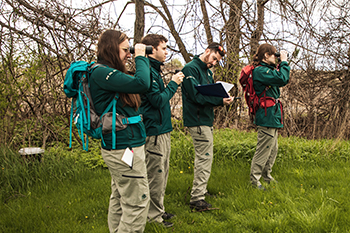
Frog Monitoring
Rouge National Urban Park
One of the best parts of taking an evening stroll outdoors is taking in all the sounds of nature. Have you ever paused to wonder what creatures were making those chirps and croaks?
Jory Mullen, the resource conservation field crew lead at Rouge National Urban Park (RNUP), and Brady Duncan, an ecological monitoring student staff member, explain that not only are these sounds easily recognizable to identify different creatures, but they are also very important to help Parks Canada staff monitor species in the Rouge.
“We do a variety of ecosystem monitoring and restoration effectiveness monitoring,” Mullen says. The team at RNUP monitors everything from turtle nesting to bat maternity roosting to vegetation survival. Duncan and Mullen both however, highlight the importance of frog monitoring.
“The health and biodiversity of ecosystems in our protected areas is something that is extremely important and is also extremely sensitive,” says Duncan. “It can change very quickly and we need to keep a finger on the pulse.”
“Amphibians are indicator species because they absorb everything through their skin,” adds Mullen. “They are literally our canary in the coal mine.”

But how does monitoring frogs actually work?
Frog monitoring starts in early spring and continues until mid-June to hear different species’ mating calls throughout varying times in the season. In the evening, the team goes to restored wetlands and does timed surveys listening to calls and recording the species they hear. For example, in early spring it is common to hear wood frogs and spring peepers.
“We’re also worried about threats,” Mullen points out. “So we’re looking at trends for the long term.”
If you are interested in volunteering with Parks Canada as an environmental monitor, there are limited spots available that are assessed on a yearly basis, but there is a waitlist. So if you are interested, please visit our website for more information. However, Mullen and Duncan also highlight that it is easy for the public to frog watch at home.
“In terms of monitoring the different calls, it’s fairly simple,” Duncan explains. “Frog calls sound very different, especially the different frogs in this area.”
Mullen also shared that two great resources for novice frog watchers are the Toronto Zoo’s Adopt-a-Pond website, which provides species descriptions and recordings of their calls, and the Ontario Nature Reptile and Amphibian Atlas free app that plays calls from your cellphone and allows you to upload your observations out in the field.
If you are outside monitoring, Mullen and Duncan stress the importance of exercising caution around edges of wetlands and staying on trail.
“Wetlands are very sensitive areas especially to physical disturbances,” stresses Duncan. “Stay out of what could possibly be a habitat.”
So next time you’re out on the trails in Rouge National Urban Park, be sure to keep an ear open for creatures; their sounds are more important than you expect!
Related links
- Date modified :